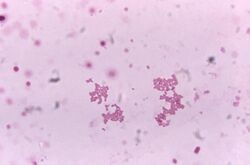Biology:Veillonella parvula
| Veillonella parvula | |
|---|---|

| |
| Scientific classification | |
| Domain: | |
| Phylum: | |
| Class: | |
| Order: | |
| Family: | |
| Genus: | |
| Species: | V. parvula
|
| Binomial name | |
| Veillonella parvula (Veillon and Zuber 1898) Prévot 1933[1]
| |
Veillonella parvula is a strictly anaerobic, Gram-negative, coccus-shaped bacterium in the genus Veillonella.[2] It is a normal part of the oral flora but can be associated with diseases such as periodontitis and dental caries as well as various systemic infections, including meningitis and osteomyelitis.[3] It has also been isolated from women with bacterial vaginosis and has been associated with hypertension together with Campylobacter rectus and Prevotella melaninogenica.[4]
V. parvula is unable to feed on carbohydrates, but can feed on lactate provided by Streptococcus species also found in the oral cavity.[5] Specifically, Streptococcus mutans and V. parvula can form multispecies biofilms that lead to a lower susceptibility to antimicrobial treatments, resulting in periodontitis and dental caries.[6]
Antimicrobial susceptibility
V. parvula bacteria are susceptible to and typically treated with metronidazole and penicillin in clinical reports.[7][8][9][10] Other antibiotics that have been shown to be active against V. parvula include cephalosporin, clindamycin, and chloramphenicol.[7]
Antibiotic resistance
There have been several reports of antibiotic resistance in V. parvula isolates in different countries.[11][12][13] In Greece, V. parvula isolates were found to be somewhat resistant to penicillin, ampicillin, piperacillin/tazobactam, clindamycin, and moxifloxacin, with no reported resistance to metronidazole.[13][14] In Taiwan, V. parvula isolates were found to be resistant against metronidazole.[15] These findings represent the growing issue of antibiotic resistance worldwide.[citation needed]
References
- ↑ "Veillonella". https://lpsn.dsmz.de/genus/veillonella.
- ↑ "Receptor recognition of and immune intracellular pathways for Veillonella parvula lipopolysaccharide". Clinical and Vaccine Immunology 16 (12): 1804–1809. December 2009. doi:10.1128/CVI.00310-09. PMID 19828771.
- ↑ "Was isolation of Veillonella from spinal osteomyelitis possible due to poor tissue perfusion?". Medical Hypotheses 63 (4): 659–661. 2004-01-01. doi:10.1016/j.mehy.2004.02.052. PMID 15325011.
- ↑ "Definition of hypertension-associated oral pathogens in NHANES". Journal of Periodontology 90 (8): 866–876. August 2019. doi:10.1002/JPER.19-0046. PMID 31090063.
- ↑ "One or two membranes? Diderm Firmicutes challenge the Gram-positive/Gram-negative divide". Molecular Microbiology 113 (3): 659–671. March 2020. doi:10.1111/mmi.14469. PMID 31975449.
- ↑ "Effect of Veillonella parvula on the antimicrobial resistance and gene expression of Streptococcus mutans grown in a dual-species biofilm". Oral Microbiology and Immunology 23 (3): 183–189. June 2008. doi:10.1111/j.1399-302X.2007.00409.x. PMID 18402603.
- ↑ Jump up to: 7.0 7.1 "Non-vertebral Veillonella species septicemia and osteomyelitis in a patient with diabetes: a case report and review of the literature". Journal of Medical Case Reports 8 (1): 365. November 2014. doi:10.1186/1752-1947-8-365. PMID 25388792.
- ↑ "Bacteremia caused by Veillonella dispar in an oncological patient". Anaerobe 66: 102285. December 2020. doi:10.1016/j.anaerobe.2020.102285. PMID 33075505.
- ↑ "Epidural abscess caused by Veillonella parvula: Case report and review of the literature". Journal of Microbiology, Immunology, and Infection = Wei Mian Yu Gan Ran Za Zhi 49 (5): 804–808. October 2016. doi:10.1016/j.jmii.2014.05.002. PMID 25066704.
- ↑ "Comparative in vitro activity of new beta-lactam antibiotics against anaerobic bacteria". Antimicrobial Agents and Chemotherapy 20 (5): 600–609. November 1981. doi:10.1128/AAC.20.5.600. PMID 7325628.
- ↑ "Non-vertebral Veillonella species septicemia and osteomyelitis in a patient with diabetes: a case report and review of the literature". Journal of Medical Case Reports 8 (1): 365. November 2014. doi:10.1186/1752-1947-8-365. PMID 25388792.
- ↑ "Two fatal cases of Veillonella bacteremia". European Journal of Clinical Microbiology & Infectious Diseases 17 (1): 62–64. January 1998. doi:10.1007/BF01584370. PMID 9512189.
- ↑ Jump up to: 13.0 13.1 "Surveillance of antimicrobial resistance in recent clinical isolates of Gram-negative anaerobic bacteria in a Greek University Hospital". Anaerobe 62: 102173. April 2020. doi:10.1016/j.anaerobe.2020.102173. PMID 32062399.
- ↑ "Evaluation of the routine antimicrobial susceptibility testing results of clinically significant anaerobic bacteria in a Slovenian tertiary-care hospital in 2015". Anaerobe 47: 64–69. October 2017. doi:10.1016/j.anaerobe.2017.04.007. PMID 28433670.
- ↑ "High incidence of cefoxitin and clindamycin resistance among anaerobes in Taiwan". Antimicrobial Agents and Chemotherapy 46 (9): 2908–2913. September 2002. doi:10.1128/AAC.46.9.2908-2913.2002. PMID 12183246.
Further reading
"The influence of oral Veillonella species on biofilms formed by Streptococcus species". Anaerobe 28: 54–61. August 2014. doi:10.1016/j.anaerobe.2014.05.003. PMID 24862495.
External links
Wikidata ☰ Q4009298 entry
 |

